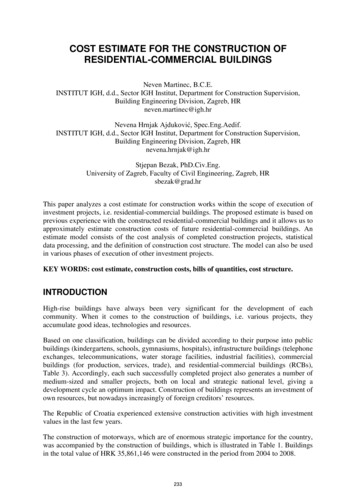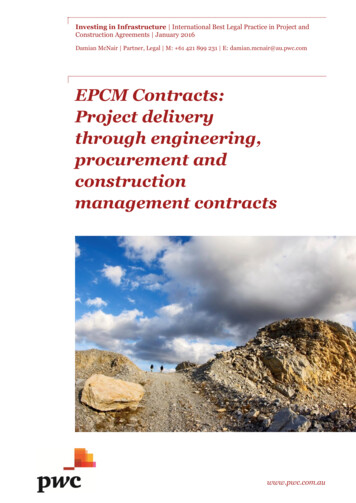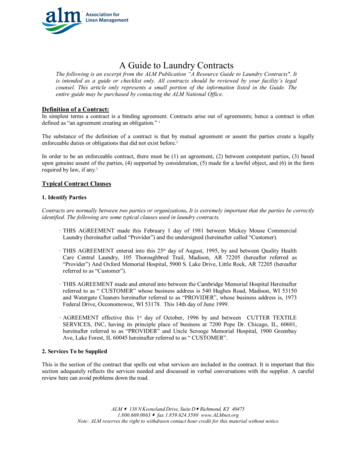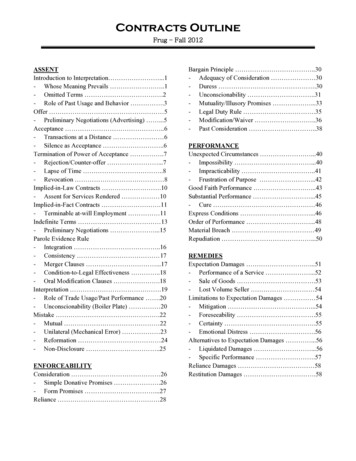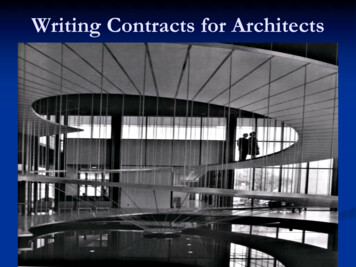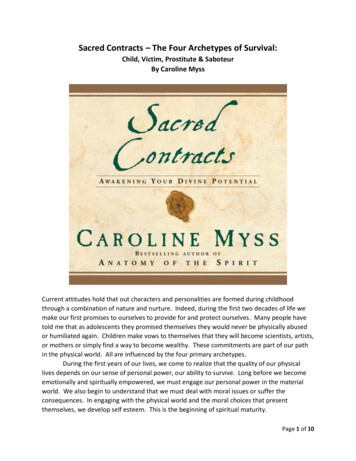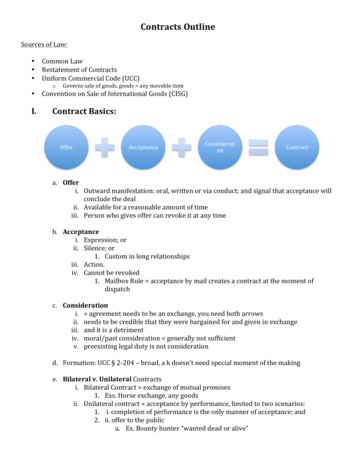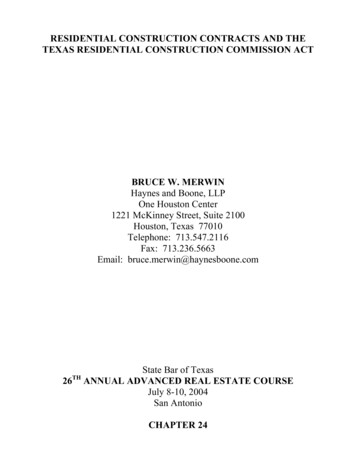
Transcription
RESIDENTIAL CONSTRUCTION CONTRACTS AND THETEXAS RESIDENTIAL CONSTRUCTION COMMISSION ACTBRUCE W. MERWINHaynes and Boone, LLPOne Houston Center1221 McKinney Street, Suite 2100Houston, Texas 77010Telephone: 713.547.2116Fax: 713.236.5663Email: bruce.merwin@haynesboone.com26THState Bar of TexasANNUAL ADVANCED REAL ESTATE COURSEJuly 8-10, 2004San AntonioCHAPTER 24
BRUCE W. MERWINAddress:Haynes and Boone, LLPOne Houston Center1221 McKinney, Suite 2100Houston, Texas 77010Office win@haynesboone.comBruce Merwin is a real estate partner at Haynes and Boone, LLP, and has been practicing realestate law for over 27 years. Bruce graduated from the University of Texas Law School in 1976. He isboard certified in Commercial Real Estate Law. He has been recognized since 2000 as one of the BestLawyers in America in Real Estate and Construction and has been listed in Chambers USA – America’sLeading Lawyers for 2003 and 2004. He also has been annually recognized as one of the Best Lawyers inHouston in Construction and Commercial Real Estate in Inside Houston Magazine’s annual survey of BestLawyers and was recently named a Super Lawyer for Real Estate by Texas Monthly.Bruce has a general real estate practice, with special emphasis in the areas of construction contracts andprofessional agreements relating to construction, the financing, development, sale and purchase ofunimproved and improved properties, condominium development, and the formation of master plannedcommunities and mixed-use developments. He has also done an extensive amount of commercial leasingrepresenting landlords and tenants.Bruce has recently worked on the Reliant Football Stadium and Toyota Multi-Purpose Arena representingthe architects. He also has recently represented the developer of eight medical buildings in the Woodlandsarea and the development of two master planned communities for two major homebuilders.Bruce is a frequent lecturer at state and local bar associations CLE seminars in the areas of construction andarchitects agreements from a transactional standpoint and the development and purchase and sale ofunimproved and improved property.
Residential Construction Contracts and the Texas Residential Construction Commission ActChapter 24TABLE OF CONTENTSINTRODUCTION . 1PART 1: THE TEXAS RESIDENTIAL CONSTRUCTION COMMISSION ACT. 1I.THE ACT . 1II.THE TEXAS RESIDENTIAL CONSTRUCTION COMMISSION . 1III. KEY DEFINITIONS IN THE ACT. 1A. Section 401.002:. 1B. Section 401.002:. 2C. Section 401.002(8): . 2D. Section 401.002 (16): . 2E. Section 401.003:. 2F. Section 401.004:. 2G. Section 401.005:. 3IV. KEY PROVISIONS IN THE ACT . 3A. Section 426.003: Home Registration. 3B. Chapter 416: Builder Registration. 3C. Chapters 418 and 419: Prohibited Practices and Disciplinary Action. 4D. Chapter 427: Third Party Independent Inspectors. 4E. Chapter 426: State-sponsored Inspection and Dispute Resolution Process. 4F. Sections 430.003, 430.004, and 436.004: Task Forces . 5G. Chapter 417, 436, 437 and 438: Residential Construction Arbitration . 5H. Section 430.001: Limited Statutory Warranties and Building and Performance Standards. 5I. Section 430.001(f): Commencement of Warranties . 6J. Section 430.002: Warranty of Habitability . 6K. Section 430.006: Implied Warranties . 6L. Section 430.007: Waiver by Contract Prohibited. 6M Sections 430.008 and 430.009: Third-Party Warranty Companies . 6V. PRACTICAL TIPS AND APPLICATION OF THE PROVISIONS . 7PART 2: RESIDENTIAL CONSTRUCTION CONTRACTS . 8I.OVERVIEW OF CONTRACT PREPARATION . 8II.TYPES OF CONTRACTS. 9A. Stipulated Sum Contract. 9B. Cost Plus Contract . 9C. Cost Plus Contract With Guaranteed Maximum Price. 9D. Design-Build Contract. 10III. KEY AREAS OF CONCERN TO OWNER’S AND CONTRACTOR’S RESPONSES. 10A. Description of the Work . 10B. Contractor’s Cost of the Work; Fee. 11C. Payment Applications. 12D. Retainage . 13E. Conditions to Final Payment . 14F. Separate Contractors. 15G. Owner-Furnished Items . 15H. Insurance . 16I. Indemnification . 17J. Warranties . 17i
Residential Construction Contracts and the Texas Residential Construction Commission ActK.L.M.O.P.Q.R.S.T.Chapter 24The Residential Construction Liability Act. 18Changes . 19Subcontractors and Subcontracts. 20Defaults and Remedies . 22Consequential Damages . 23Owner’s Right to Terminate Without Cause . 23Mediation/Dispute Resolution. 24Concealed or Unknown Conditions. 24Cooperation With Lender . 25APPENDIXItem A – Agreement for Construction – Owner’s FormItem B – Cost of the Work DefinitionItem C – Design/Build Obligations of ContractorItem D – Termination Without Cause ProvisionItem E-1 – Addendum to Residential Construction Contract (Stipulated Price)Item E-2 – Addendum to Residential Construction Agreement (Cost PlusItem F – Addendum to Residential Sale & Construction ContractItem G – Modifications to AIA A107 – including Supplement to General ConditionsItem H –Agreement (Contractor’s Form with Owner’s Provisions blacklined)Item I – Disclosure Statement required for Residential Construction ContractItem J – GHBA Residential Construction ContractItem K – GHBA Residential Construction Contract – Cost PlusItem L – GHBA Residential Sale & Construction ContractItem M – Owner’s Revision of Contractor Form (Based on GHBA Cost Plus Form)******I would like to acknowledge the assistance of John Krugh, the Vice President and Corporate Counsel of Perry Homesand member of the Texas Residential Construction Commission from whom I received a substantial amount ofbackground information for Part I of the presentation. I would also like to acknowledge Jennie Do, a first yearstudent at the University of Texas and summer associate at Haynes and Boone, LLP, for her excellent work in editingthis outline.ii
Residential Construction Contracts and the Texas Residential Construction Commission ActChapter 24general liability policy; (d) weakened the originalpurpose and intent of the Texas ResidentialConstruction Liability Act; and (e) created doubt as towhether mental anguish and punitive damages could berecovered in a construction defect case.From the builder’s perspective, the impact ofthese decisions on the housing industry was significant.Builders were exposed to undefined and uninsuredliability for implied warranties that were difficult, ifnot impossible, to contractually disclaim. On top ofthis, most insurance carriers that wrote general liabilityinsurance for builders quit writing builders insurance inTexas, and those that stayed raised their premiumssignificantly and increased their coverage exclusions.The education that Owners should receivepursuant to the Act as a result of the dispute resolutionprocess, adoption of limited warranties and buildingand performance standards and registration of Buildersand homes will hopefully improve consumerconfidence in the homebuilding industry.RESIDENTIALCONSTRUCTIONCONTRACTS AND THE TEXASRESIDENTIALCONSTRUCTIONCOMMISSION ACTINTRODUCTIONThis presentation has two main focus points. In Part Iof the presentation, I will focus on a brief overview ofthe Texas Residential Construction Commission Act(“Act”) and the functions that the Texas ResidentialConstruction Commission (“Commission”) serves. Iwill then discuss a few definitions and key provisionspertinent to the Act and move into a discussion of theeffect that the Act will have on purchase and saleagreements involving new construction and residentialcontracts.Since it should not take very long to provide anoverview of the Texas Residential ConstructionCommission Act, Part II of this presentation will focuson the practical concerns relevant to the drafting andnegotiation of contracts that attorneys representingOwners should be aware of. I will start the discussionof Part II of the presentation by briefly describinggeneral steps involved in contract preparation,including a brief overview of major types of contracts.Part II of the presentation will close with a summationof the key areas of concern to Owners, from both theOwner’s and Contractor’s perspective.II. THETEXASRESIDENTIALCONSTRUCTION COMMISSIONThe Commission has six primary responsibilities:(1) register homes and homebuilders, (2) oversee thestate-sponsored inspection process, (3) prepare andadopt new building performance standards, (4) managethree task force groups, (5) provide a voluntarycertification of arbitrators, and (6) provide for the filingof arbitration awards. The Commission is composed ofnine members appointed by the Governor: fourregistered builders, three members of the generalpublic, one engineer who practices in the area ofresidential construction and either one architect orinspector who practices in the area of residentialconstruction. These appointments were made byGovernor Perry in early September, 2003. TheCommission members serve six-year terms. The initialmembers are serving staggered terms. Three members’terms expire February 1, 2005, three members’ termsexpire February 1, 2007 and three members’ termsexpire February 1, 2009.The Commission is required to prepareinformation for the public concerning the function ofthe Commission, the provisions of the limited statutorywarranty and building and performance standards, thestate-sponsored inspection and dispute resolutionprocess and the procedures by which complaints orrequests are filed with the Commission. Thisinformation must be mailed to a homeowner withinthirty (30) days following the registration of a home.PART 1: The Texas Residential ConstructionCommission ActI.THE ACTThe Texas Residential Construction CommissionAct, which is found in Title 16 of the Texas PropertyCode, Chapters 401 et. seq., should have a majorimpact on the resolution of disputes between Buildersand Owners relating to construction defects through theneutral dispute resolution process established by theAct, by establishing the new Texas ResidentialConstruction Commission (“Commission”).In the past, disputes between builders andconsumers involving construction defects have all toooften been resolved in a courtroom. This wasunfortunate for both sides because of the time andexpense involved. This situation was caused, in largepart, by appellate court decisions that: (a) createdimplied warranties of good and workmanlikeconstruction and habitability, but failed to adequatelydefine what these warranties covered; (b) eliminated orrestricted a builder’s ability to contractually disclaimthese implied warranties; (c) determined that damagesarising from a breach of either the implied warrantieswere not covered under the builder’s commercialIII. KEY DEFINITIONS IN THE ACTA. Section 401.002:“Applicable building and performance standards”means:1
Residential Construction Contracts and the Texas Residential Construction Commission Act1.2.B.(b) The term includes:building and performance standards adoptedunder Section 430.001; orfor homes constructed before the adoption ofbuilding and performance standards underSection 430.001, the building andperformance standards under any expresswarranty provided in writing by the builderor, if there is no express warranty, the usualand customary residential constructionpractices in effect at the time of theconstruction.(1) an owner, officer, director, shareholder,partner, affiliate, or employee of the builder;(2) a risk retention group governed by Article21.54, Insurance Code, that insures all or anypart of a builder’s liability for the cost torepair a residential construction defect; and(3) a third-party warranty company and itsadministrator.(c) The term does not include any business entity orindividual who has been issued a license by thisstate or an agency or political subdivision of thisstate to practice a trade or profession related to oraffiliated, with residential construction if the workbeing done by the entity or individual to the homeis solely for the purpose for which the license wasissued.Section 401.002:“Applicable warranty period” means:1.2.Chapter 24a warranty period established under Section430.001 (1,2 and 10 year warranties); orfor construction to which the warrantyperiods adopted under Section 430.001 donot apply, any other construction warrantyperiod that applies to the construction.Therefore, the Act applies to the person or entityinvolved in the construction of a new home, amaterial improvement to a home (other than a roofrepair or replacement) or an improvement to theinterior of an existing home when the cost exceeds 20,000.00. It also applies to the insurer insuringall or part of a Builder’s liability to repairconstruction defects and the third-party warrantycompany which agrees to be responsible forrepairing construction defects. It would not applyto an architect or engineer not involved inconstruction.C. Section 401.002(8):“Limited statutory warranty and building andperformance standards” means the limited statutorywarranty and building and performance standardsadopted by the Commission under Section 430.001(currently scheduled to be adopted this summer).D. Section 401.002 (16):“Warranty of habitability” means a builder’sobligation to construct a home or home improvementthat is in compliance with the limited statutorywarranties and building and performance standardsadopted by the Commission under Section 430.001 andthat is safe, sanitary and fit for humans to inhabit.F.Section 401.004:“Construction Defect” means:(a) In this title, “Construction Defect” means:E.Section 401.003:“Builder” means:(1) the failure of the design, construction, orrepair of a home, an alteration of or a repair,addition, or improvement to an existinghome, or an appurtenance to a home to meetthe applicable warranty and building andperformance standards during the applicablewarranty period; and(2) any physical damage to the home, anappurtenance to the home, or real property onwhich the home or appurtenance is affixedthat is proximately caused by that failure.(a) any business entity or individual who, for a fixedprice, commission, fee, wage, or ot
warranty provided in writing by the builder or, if there is no express warranty, the usual and customary residential construction practices in effect at the time of the construction. B. Section 401.002: “Applicable warranty period” means: 1. a warranty period established

